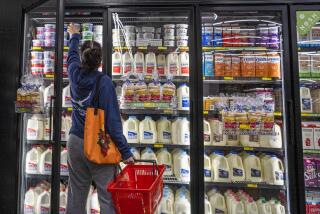Keeping a Lid on Inflation
- Share via
T he Labor Department’s producer price index, released Friday, rose a barely perceptible 0.1% in August, despite the fact fruit costs shot up by the largest percentage in 20 years. The index measures prices paid by wholesalers to producers, such as farms and factories. Although it tracks only the cost of goods, not services, its performance usually foreshadows consumer price movements. The tiny, seasonally adjusted increase matched the gain in July and, according to economists, was a symptom of weak demand resulting from the near standstill in economic growth. Good news: Declines in the costs of gasoline and fuel oil, tobacco and children’s clothing helped offset higher food costs. The price of children’s clothing dropped 0.7%. Tobacco was down 5.6%, the biggest decline since 1983. For the first eight months of this year, producer price inflation has been running at an annual rate of 1.7%. The index fell 0.1% last year, pulled down by a drop in oil prices that came with the end of the Persian Gulf War. “For now, at least, there is little or no inflation,” said economist Norman Robertson of Mellon Bank in Pittsburgh. “This is the one positive aspect of having a period of very slow economic growth.” Analysts said that the weak economy should subdue price pressures into next year, but that Hurricane Andrew and recent declines in the value of the dollar should keep inflation from disappearing entirely.
Bad news: Fruit costs increased 16.9%, the largest since July, 1972, and vegetable prices jumped 30.2%. Lettuce prices tripled, and strawberry prices soared by 70%. Labor Department analysts said alternating hot and cold spells in California’s Salinas Valley hurt the lettuce, broccoli, cauliflower and strawberry crops in particular, while floods washed out fields in New York and New Jersey. Overall, food prices advanced 0.7%, the steepest in six months. Costs of chicken, beef and eggs also rose. Prices also climbed for magazines and prescription drugs. New car prices increased 1% on a seasonally adjusted basis because dealers had slapped discounts on the vehicles earlier in the summer than usual.
Producer Price Index
For finished goods
Seasonally adjusted change from prior month
Aug., ‘92: +0.1%
July, ‘92: +0.1%
Aug., ‘91: +0.2%
Source: Labor Department
More to Read
Inside the business of entertainment
The Wide Shot brings you news, analysis and insights on everything from streaming wars to production — and what it all means for the future.
You may occasionally receive promotional content from the Los Angeles Times.









